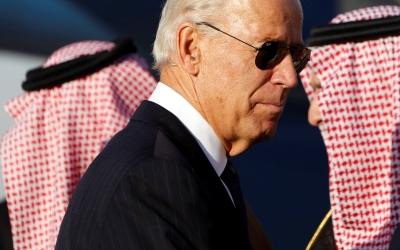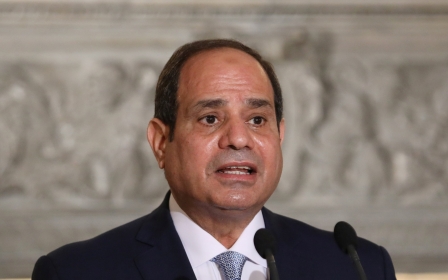How will Biden shape US policy towards the Middle East?

Will Joe Biden’s presidency lead to a shift in US policy towards the Middle East? Certainly, there may be some tonal differences, as Biden prioritises certain issues over others. There are expectations that his presidency will contrast with those of Donald Trump and his predecessor, Barack Obama. Both Obama and Trump campaigned with the aim of reducing US involvement in the Middle East, with Obama keen to “pivot” US resources and focus towards East Asia.
Some judge Biden to be less “naive” than Trump and Obama, owing to his experience in foreign affairs while serving in the Senate. He may be less beholden to regional autocrats than Trump was, which is reflected in some of the consternation among leaders in Saudi Arabia, Turkey, Egypt and Israel, who fear that Biden will not be as sympathetic to their concerns.
Tone over substance
Biden may place a greater emphasis on human rights in his dealings with Saudi Arabia. While he is unlikely to reverse Trump’s decision to move the US embassy to Jerusalem, he may be more attentive to Palestinian concerns. He may also look to ease Trump’s strategy of maximum pressure against Iran and return to the nuclear deal, whereby sanctions were lifted in exchange for Iran freezing its nuclear programme.
But even if Biden does carry out these actions, it will mark a difference in tone rather than substance. Regardless of personality and preferences, there are wider structural challenges and constraints that will limit US room for maneuvering. This is the result of both previous US actions, as well as those beyond its control, with which not only Biden, but Obama and Trump have had to grapple.
The US is the world's sole remaining superpower ... but that will count for little, if Biden is unable to advance American interests
For one, US influence is widely seen to have waned globally and regionally. That process began after 2003, when a US military victory failed to deliver a stable and secure Iraq. Instead, it resulted in an occupation, a weak state and an ongoing insurgency. Its failure was especially significant, given the relatively unconstrained state of the world at the time.
The Iraq invasion was probably the high point of US unipolarity and the last moment of “idealism” - in particular, the neoconservative belief that Saddam Hussein’s Baathist regime could be smashed and a liberal democracy and market economy created in its place, to serve as a beacon for the region. Since then, the 2008 global financial crisis and the Trump administration’s failure to manage the Covid-19 pandemic have compounded the sense of American ineffectiveness.
2011 uprisings
The perceived US decline has been exacerbated by developments within the Middle East over the past decade - changes that have resulted in regional and extra-regional powers becoming more independent. The uprisings in 2011 unleashed internal and external turbulence that confronted and weakened many states across the region.
They faced pressure from both state and non-state actors, from armed groups to Gulf monarchies, Iran, Turkey and Russia. External powers have taken advantage of the situation to pursue their own interests and rivalries in the form of proxy conflicts, from Syria to Yemen and Libya to Lebanon.
The limits of US influence during this period have been compounded by its own strategic decisions over the past decade. This included decisions to either retreat or stand apart, whether by downgrading US involvement in Libya after the Benghazi attack in 2012 or stepping back from intervening against the Syrian government for using chemical weapons in 2013.
There have also been doubts raised among US allies of American commitment, fuelled by Obama’s prevarication over support for President Hosni Mubarak in Egypt in 2011, Trump’s proposal to withdraw troops from northern Syria and expose his Kurdish allies to Turkish ambitions, and Trump’s unwillingness to act against suspected Iranian involvement in an attack on Saudi oil facilities last year.
The volatile situation in the region arrived on Obama’s watch, and Trump - and now Biden - have had to respond. The Middle East has moved from a space of primarily multipolar competition into a more bipolar system, based around two main groups, with Saudi Arabia, the UAE, Israel and Egypt on one side, and Iran, Turkey and Qatar on the other. Yet, these changing dynamics do not suggest any substantial shift in the balance of power; neither axis is sufficiently strong or organised to overcome the other.
Proactive and reactive measures
The presence of so many different actors and interests, which cut across the region and national borders, shows how the Middle East is a system with many moving parts. This will cause complications for Biden. The US is the world’s sole remaining superpower, with more economic and military resources than any other - but that will count for little, if Biden is unable to advance American interests.
The recent publication of Obama’s presidential memoir is telling in this respect. Despite supporting democracy and seeking to reset relations with the region in his Cairo speech in 2009, he chose not to oppose Saudi intervention against pro-democracy protests in Bahrain. Rather than embrace change, with all the uncertainty and long-term commitment it would have implied, he instead accepted the status quo.
Given the circumstances, then, perhaps the most that can be said about Biden’s Middle East policy is that it will most likely be a combination of proactive and reactive measures, focused more on short-term rather than medium- to long-term objectives. Some of these may work out as intended, while others will not. But however the US engages with the Middle East over the next four years, it is unlikely that it will be solely based on Biden’s own personal preferences and objectives.
The views expressed in this article belong to the author and do not necessarily reflect the editorial policy of Middle East Eye.
Middle East Eye propose une couverture et une analyse indépendantes et incomparables du Moyen-Orient, de l’Afrique du Nord et d’autres régions du monde. Pour en savoir plus sur la reprise de ce contenu et les frais qui s’appliquent, veuillez remplir ce formulaire [en anglais]. Pour en savoir plus sur MEE, cliquez ici [en anglais].







